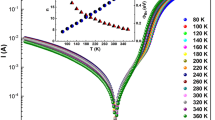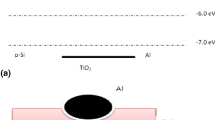Abstract
The effects of the TiO2 high-k insulator material on Au/n-GaAs/Ti/Au Schottky barrier diodes have been studied by means of the numerical simulation and experimental results at room temperature. The Atlas-Silvaco-TCAD numerical simulator has been used to explain the behavior of different physical phenomena of Schottky diode. The experimental values of ideality factor, barrier height, and series resistance have been determined by using the various techniques such as Cheung’s method, forward bias lnI–V and reverse capacitance–voltage behaviors. The experimental ideality factor and barrier height values have been found to be 4.14 and 0.585 eV for Au/n-GaAs/Ti/Au Schottky barrier diode and 4.00 and 0.548 eV for that structure with 16 nm thick TiO2 film and 3.92, 0.556 eV with 100 nm thick TiO2 film. The diodes show a non-ideal current–voltage behavior that of the ideality factor so far from unity. The extraction of Nss interface distribution profile as a function of Ec–Ess is made using forward-bias I–V measurement by considering the bias dependence of ideality factor, the effective barrier height, and series resistance for Schottky barrier diodes. The Nss calculated values with consideration of the series resistance are lower than the calculated ones without series resistance. The current–voltage results of diodes reveal an abnormal increase in leakage current with an increase in thickness of high-k interfacial insulator layer. However, the simulation agrees in general with the experimental results.





Similar content being viewed by others
References
W. Yang, J. Marino, A. Monson, C.A. Wolden, An investigation of annealing on the dielectric performance of TiO2 thin films. Semicond. Sci. Technol. 21(12), 1573–1579 (2006)
K.J. Han, K.S. Kang, Y. Chen, K.H. Yoo, J. Kim, Effect of annealing temperature on the conduction mechanism for a sol–gel driven ZnO Schottky diode. J. Appl. Phys D Appl. Phys. 42, 125110 (2009) (p. 5)
S.X. Zhang, D.C. Kundaliva, W. Yu, S. Dhar, S.Y. Young, L.G. Salamanca-Riba, S.B. Ogale, R.D. Vispute, T. Venkatesan, Niobium doped TiO2: intrinsic transparent metallic anatase versus highly resistive rutile phase. J. Appl. Phys. 102(1), 013701 (2007) (p. 4)
W. Li, C. Ni, H. Lin, C.P. Huang, S. Ismat Shah, Size dependence of thermal stability of TiO2 nanoparticles. J. Appl. Phys. 96(11), 6663–6668 (2004)
N.R. Mathews, E.R. Morales, M.A. Corte-Jacome, J.A. Toledo Antonio, TiO2 thin films-influence of annealing temperature on structural, optical and photocatalytic properties. Sol. Energy 83(9), 1499–1508 (2009)
O. Pakma, N. Serin, T. Serin, Ş Altindal, The effects of preparation temperature on the main electrical parameters of Al/TiO2/p-Si (MIS) structures by using sol–gel method. J. Sol Gel Sci. Technol. 50(1), 28–34 (2009)
Z. Tekeli, Ş. Altındal, M. Çakmak, S. Özçelik, D. Çalışkan, E. Özbay, The behavior of the I–V–T characteristics of inhomogeneous (Ni/Au)–Al0.3Ga0.7N/AlN/GaN heterostructures at high temperatures. J. Appl. Phys. 102(5), 054510 (2007) (p. 8)
H. Altuntas, A. Bengi, U. Aydemir, T. Asar, S.S. Cetin, I. Kars, S. Altindal, S. Ozcelik, Electrical characterization of current conduction in Au/TiO2/n-Si at wide temperature range. Mater. Sci. Semicond. Proc. 12, 224–232 (2009)
O. Pakma, N. Serin, T. Serin, Ş Altindal, The double Gaussian distribution of barrier heights in Al/TiO2/p-Si (metal-insulator-semiconductor) structures at low temperatures. J. Appl. Phys. 104(1), 014501 (2008) (p. 6)
D.E. Yıldız, Ş Altındal, H. Kanbur, Gaussian distribution of inhomogeneous barrier height in Al/SiO2/p-Si Schottky diodes. J. Appl. Phys. 103(12), 124502 (2008) (p. 7)
J. M. D. Coey, d0 ferromagnetism, Solid State Sci. 7(6), 660–667 (2005)
H.-Y. Guo, Z.-G. Ye, Electric characterization of HfO2 thin films prepared by chemical solution deposition. Mater. Sci. Eng. B 120(1–3), 68–71 (2005)
L. Truong, Y.G. Fedorenko, V.V. Afanasev, A. Stesmans, Admittance spectroscopy of traps at the interfaces of (100)Si with Al2O3, ZrO2, and HfO2. Microelectron. Reliab. 45(5–6), 823–826 (2005)
L. Yang, S.S. Saavedra, N.R. Amstrong, J. Hayes, Fabrication and characterization of low-loss, sol-gel planar waveguides. Anal. Chem. 66(8), 1254–1263 (1994)
K. Zawreska, M. Radeska, M. Rekas, Effect of Nb, Cr, Sn additions on gas sensing properties of TiO2 thin films. Thin Solid Films 310, 161–166 (1997)
G.P. Smestad, S. Spiekermann, J. Kowalik, C.D. Grant, A.M. Schwartzberg, J. Zhang, L.M. Tolbert, E. Moons, Moons, A technique to compare polythiophene solid-state dye sensitized TiO2 solar cells to liquid junction devices. Solar Energy Mater. Solar Cell 76(3), 85–105 (2003)
H. Köstlin, G. Frank, G. Hebbinghaus, H. Auding, K. Denisen, Optical filters on linear halogen-lamps prepared by dip-coating. J. Non Cryst. Solids 218, 347–353 (1997)
A. Bengi, U. Aydemir, Ş Altindal, Y. Özen, S. Özçelik, A comparative study on the electrical characteristics of Au/n-Si structures with anatase and rutile phase TiO2 interfacial insulator layer. J. Alloy. Compd. 505, 628–633 (2010)
SILVACO-TCAD, ATLAS User’s Manual: device simulation software (SILVACO International, Santa Clara, 2013)
S. Parui, A. Atxabal, M. Ribeiro, A. Bedoya-Pinto, X. Sun, R. Llopis, F. Casanova, L.E. Hueso, Reliable determination of the Cu/n-Si Schottky barrier height by using in-device hot-electron spectroscopy. Appl. Phys. Lett. 107(18), 183502 (2015) (p. 5)
A. Fritah, A. Saadoune, L. Dehimi, B. Abay, Investigation on the non-ideal behaviour of Au/n-InP Schottky diodes by the simulation of I–V–T and C–V–T characteristics. Philos. Mag. 96(19), 2009–2026 (2016)
S. M. Sze, Physics of Semiconductor Devices, 3rd edn. (Wiley, New Jersey, NJ, 2007)
M. Ieong, P.M. Solomon, S.E. Laux, H.-S.P. Wong, D. Chidambarrao, Comparison of raised and Schottky source/drain MOSFETs using a novel tunneling contact model. IEDM’98. Technical Digest, San Francisco, CA, December 6–9, 733–736 (1998)
G.K. Dalapati, T.K.S. Wong, Y. Li, C.K. Chia, A. Das, C. Mahata, H. Gao, S. Chattopadhyay, M.K. Kumar, H.L. Seng, C.K. Maiti, D.Z. Chi, Characterization of epitaxial GaAs MOS capacitors using atomic layer-deposited TiO2/Al2O3 gate stack: study of Ge auto-doping and p-type Zn doping. Nanoscales Res. Lett. 7(1), 99 (2012) (p. 8)
Y. Seo, S. Lee, I. An, C. Song, H. Jeong, Conduction mechanism of leakage current due to the traps in ZrO2 thin film. Semicond. Sci. Technol. 24(11), 115016 (2009) (p. 5)
Y. Xuan, H.-C. Lin, P.D. Ye, Simplified surface preparation for GaAs passivation using atomic layer-deposited high-κ dielectrics. IEEE Trans. Electron Devices 54(8), 1811–1817 (2007)
B.H. Lee, Y. Jeon, K. Zawadzki, W.J. Qi, J. Lee, Effects of interfacial layer growth on the electrical characteristics of thin titanium oxide films on silicon. Appl. Phys. Lett. 74(21), 3143–3145 (1999)
S. Ashok, J.M. Borrego, R.J. Gutmann, Electrical characteristics of GaAs MIS Schottky diodes. Solid State Electron. 22(7), 621–631 (1979)
B. Kınacı, T. Asar, Y. Özen, S. Özçelik, The analysis of Au/Ti02/n-Si Schottky barrier diode at high temperatures using I–V characteristics. Optoelectron. Adv. Mater. Rapid Commun. 5(4), 434–437 (2011)
N.A. Torkhov, Formation of a native-oxide structure on the surface of n-GaAs under natural oxidation in air. Semiconductors 37(10), 1177–1184 (2003)
S.K. Cheung, N.W. Cheung, Extraction of Schottky diode parameters from forward current-voltage characteristics. Appl. Phys. Lett. 49, 85–87 (1986)
H. Yamamoto, O. Oda, M. Seiwa, M. Taniguchi, H. Nakata, M. Ejima, Microscopic defects in semi-insulating GaAs and their effect on the FET device performance. J. Electrochem. Soc. 136(10), 3098–3102 (1989)
E. H. Rhoderick, R. H. Williams, Metal-Semiconductor Contacts, 2nd edn. (Clarendon, Oxford, 1988)
J. Sztkowski, K. Sieranski, Simple interface-layer model for the nonideal characteristics of the Schottky-barrier diode. Solid State Electron. 35(7), 1013–1015 (1992)
P. Cova, A. Singh, R.A. Masut, A self-consistent technique for the analysis of the temperature dependence of current–voltage and capacitance–voltage characteristics of a tunnel metal-insulator-semiconductor structure. J. Appl. Phys. 82, 5217–5226 (1997)
L.F. Wagner, R.W. Young, A. Sugerman, A note on the correlation between the Sehottky-diode barrier height and the ideality actor as determined from I–V measurements. IEEE Electron Device Lett. 4(9), 320–322 (1983)
M. Siad, A. Keffous, S. Mamma, Y. Belkacem, H. Menari, Correlation between series resistance and parameters of Al/n-Si and Al/p-Si Schottky barrier diodes. Appl. Surf. Sci. 236(1–4), 366–376 (2004)
S. Forment, R.L. Van Meirhaeghe, A. De Vrieze, K. Strubbe, W.P. Gomes, A comparative study of electrochemically formed and vacuum-deposited n-GaAs/Au Schottky barriers using ballistic electron emission microscopy (BEEM). Semicond. Sci. Technol. 16(12), 975–981 (2001)
B. Kınacı, T. Asar, S.Ş. Çetin, Y. Özen, K. Kızılkaya, Electrical characterization of Au/ZnO/TiO2/n-Si and (Ni/Au)/ZnO/TiO2/n-Si Schottky diodes by using current–voltage measurements. J Optoelectron. Adv. Mater. 14(11–12), 959–963 (2012)
H. Altuntas, A. Bengi, T. Asar, U. Aydemir, B. Sarıkavak, Y. Ozen, Ş Altındal, S. Ozcelik, Interface state density analyzing of Au/TiO2(rutile)/n–Si Schottky barrier diode. Surf. Interface Anal. 42(6–7), 1257–1260 (2010)
A. Tataroğlu, Ş Altındal, The analysis of the series resistance and interface states of MIS Schottky diodes at high temperatures using I–V characteristics. J. Alloys Compd. 484(1–2), 405–409 (2009)
M.K. Hudait, S.B. Krupanidhi, Effects of thin oxide in metal-semiconductor and metal-insulator-semiconductor epi-GaAs Schottky diodes. Solid State Electron. 44(6), 1089–1097 (2000)
Acknowledgements
This work is supported by the Ministry of Development of Turkey under Project number: 2016K121220.
Author information
Authors and Affiliations
Corresponding author
Rights and permissions
About this article
Cite this article
Zellag, S., Dehimi, L., Asar, T. et al. Effects of the TiO2 high-k insulator material on the electrical characteristics of GaAs based Schottky barrier diodes. Appl. Phys. A 124, 84 (2018). https://doi.org/10.1007/s00339-017-1463-7
Received:
Accepted:
Published:
DOI: https://doi.org/10.1007/s00339-017-1463-7




